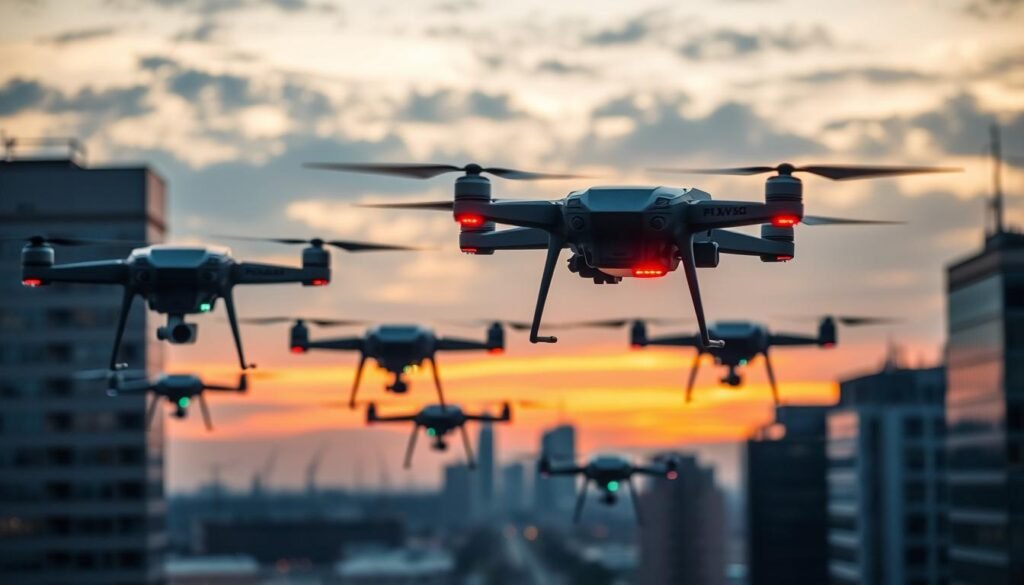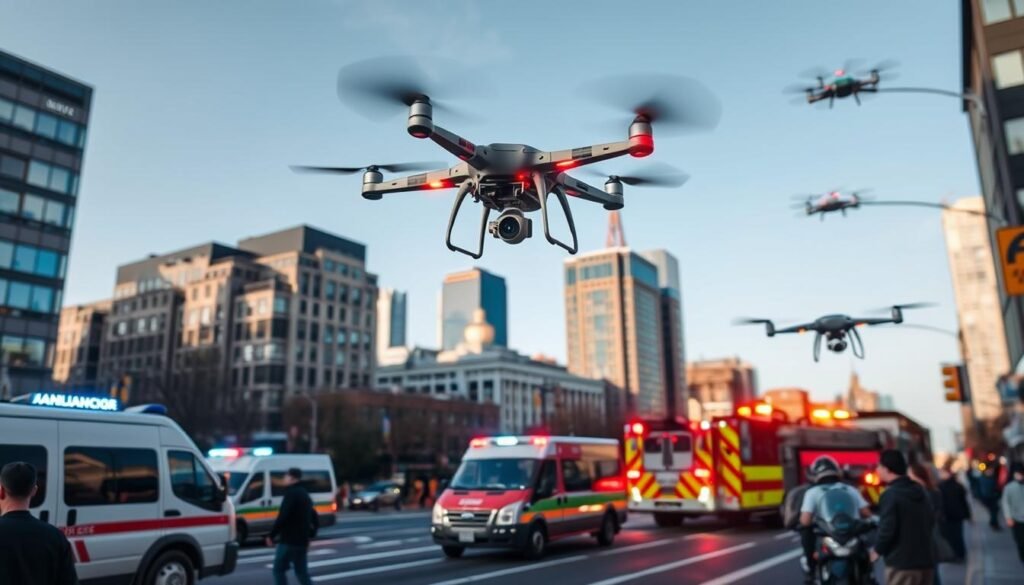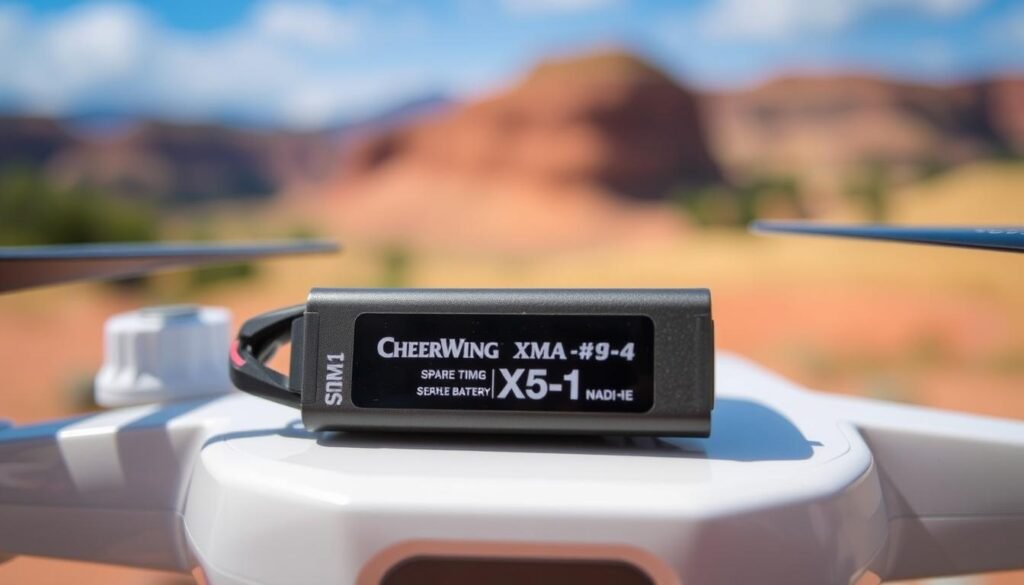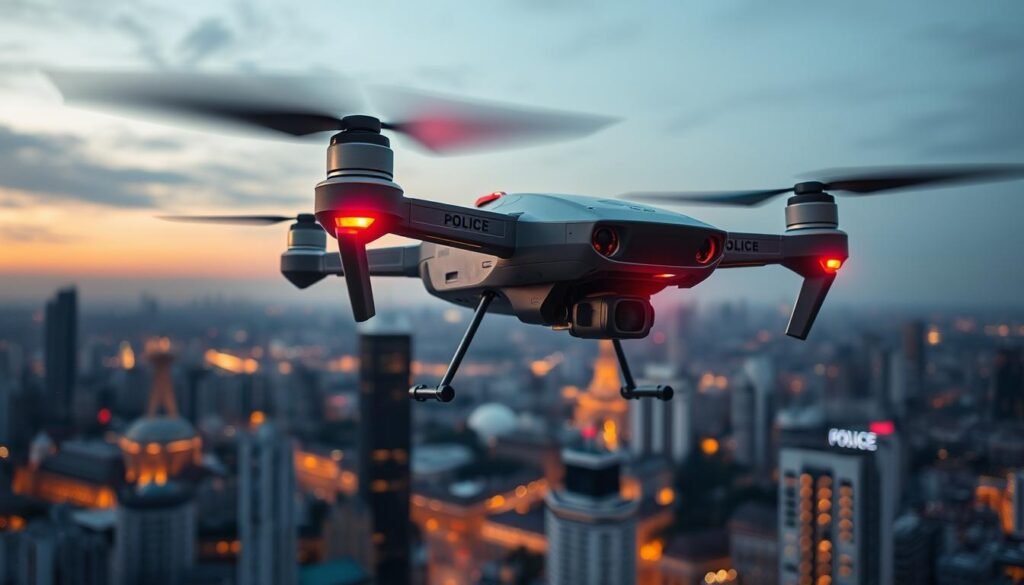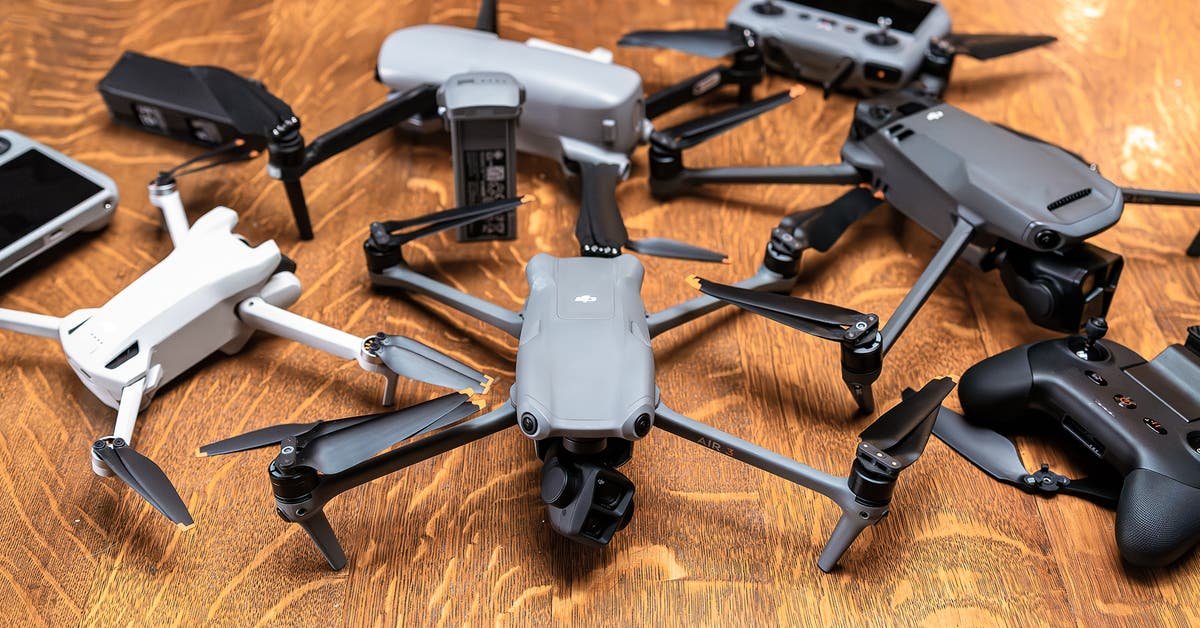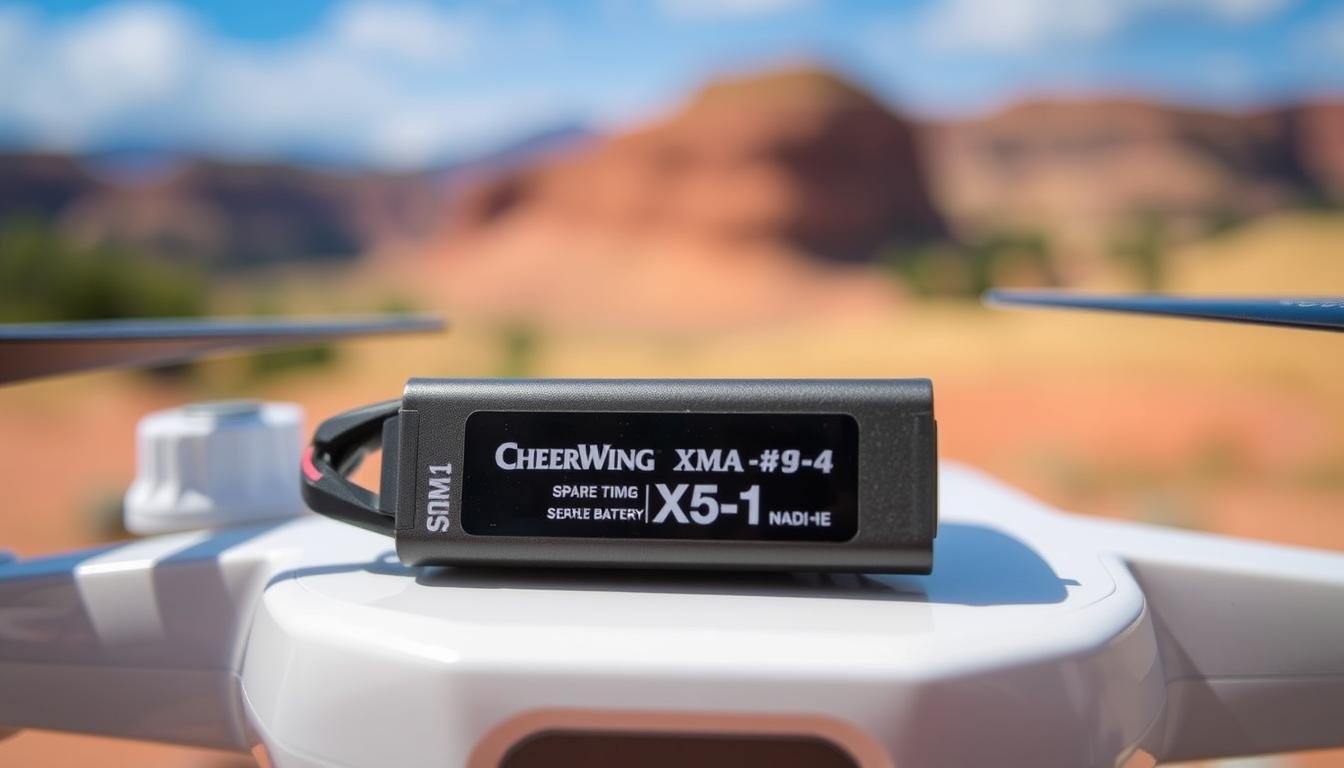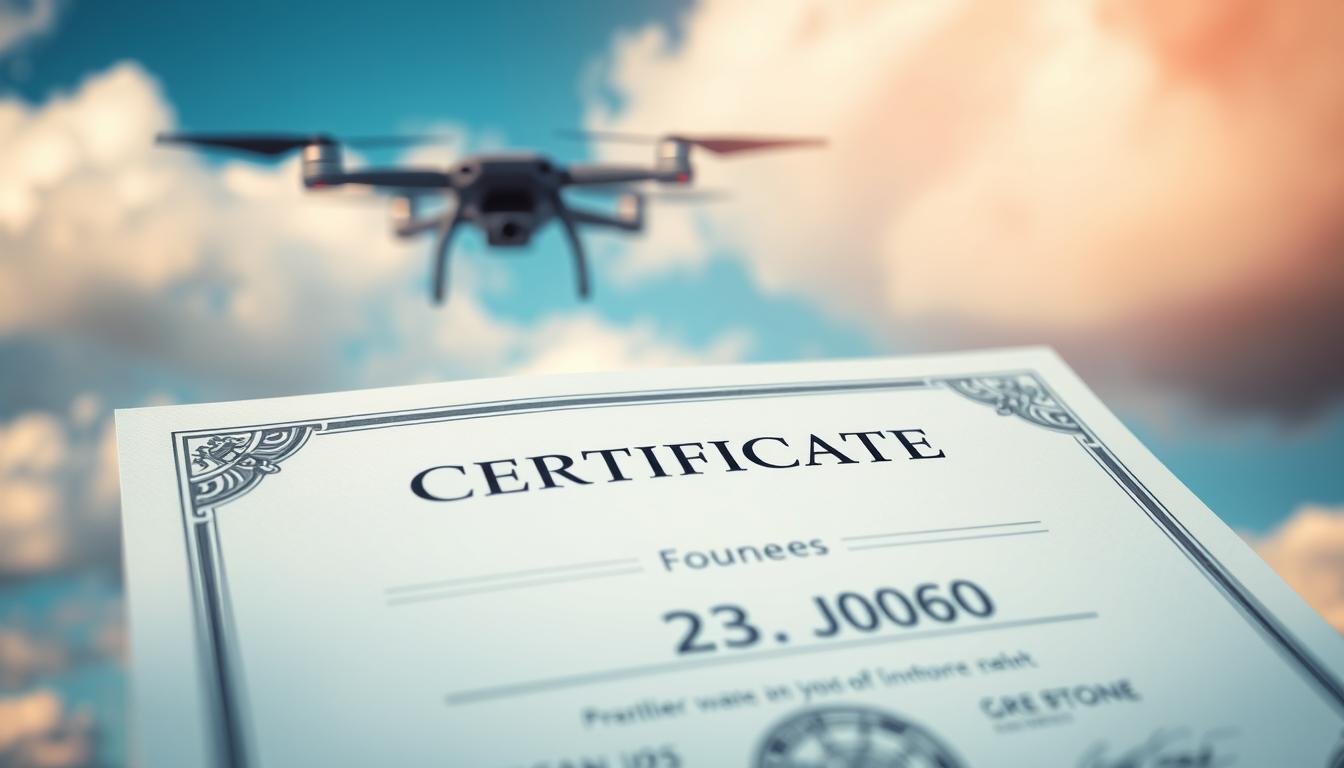I used to be a first responder. I know how tough it is for our heroes. They risk their lives to keep us safe. The Drones for First Responders Act gives them the tools to do their job better and stay safe.
This act changes how we handle emergencies with drones. These drones have cameras and can send data fast. They help first responders see what’s happening over a wide area. This is key for search and rescue, disaster work, and keeping borders safe.
Key Takeaways
- The Drones for First Responders Act is empowering first responders with enhanced situational awareness, improved response times, and safer working conditions.
- Drones equipped with high-resolution cameras and real-time data processing can cover vast areas quickly, providing first responders with crucial information.
- The act enables the use of drones for a variety of critical tasks, including search and rescue missions, disaster management, border surveillance, and law enforcement operations.
- Cutting-edge drone technology is revolutionizing emergency response, allowing first responders to make more informed decisions and save more lives.
- The Drones for First Responders Act is a testament to the power of innovation in empowering our heroic first responders.
The Drones for First Responders Act: Revolutionizing Emergency Response
The Drones for First Responders (DFR) Act is changing emergency response. It uses 5G technology to help first responders. This law gives them real-time data and better tools to save lives.
5G is key to the DFR Act’s success. It can send lots of data fast, making communication quick. It also has low latency and high reliability, making data transfer smooth.
5G lets emergency services reach more areas. It supports many devices and works well even at high speeds. This makes drones more useful for first responders.
A study found 90% of first responders in the U.S. use drones made in China. The DFR Act wants to change this. It plans to raise tariffs on Chinese drones to 70% by 2030.
The money from these tariffs will help first responders buy safe drones. These drones will be made in the U.S. or by allies. This will help the American drone industry grow.
“The DFR Act is a game-changer for first responders, empowering them with the tools and technology they need to save more lives during critical situations,” said Chief Charles Werner, Director of Public Safety UAS Alliance DRONERESPONDERS. “By addressing the reliance on Chinese-made drones and supporting the development of domestic alternatives, this legislation will revolutionize emergency response operations.”
The DFR Act is making emergency response better. It combines 5G and drones for faster and more effective crisis management.
Drones for Search and Rescue Missions
The Drones for First Responders Act gives first responders advanced drones. These drones use 5G for fast data and high-quality cameras. They can quickly find missing people in emergencies.
5G’s fast data lets teams see images and videos right away. This helps them find people in trouble fast. It’s especially helpful in hard-to-reach places or bad weather.
Leveraging 5G for Real-Time Aerial Surveillance
The Drones for First Responders Act changes search and rescue. It gives teams real-time views and data. The DJI Matrice 30, for example, has sensors for safe flying.
- The Autel EVO MAX 4T Bundle has a thermal camera for finding heat signatures. It works well in dark places.
- The Autel EVO II Dual 640T Enterprise Bundle V3 flies for up to 38 minutes. This lets teams search longer.
- The DJI Mavic 3 Thermal (Care Basic) has sensors for safe flying. It keeps the drone and its operators safe.
With the Drones for First Responders Act, first responders can save more lives. They use 5G and advanced drones for better search and rescue. This new way of responding to emergencies makes our communities safer.
Enhancing Situational Awareness with Drone Technology
The Drones for First Responders Act is changing emergency response. It gives first responders advanced drone tech. These drones have high-resolution cameras and can process data fast.
Drone tech gives first responders real-time info. They can make better decisions and use their resources wisely. For example, drones help find victims and spot dangers during disasters.
The Hebron Fire Protection District uses drones in bad weather. They help after lightning strikes.
- Drones with thermal cameras find heat in attic spaces after lightning. This saves resources.
- The Durham Fire Department uses drones to find missing people. This keeps firefighters safe.
- The Burleson County Sheriff’s Office used a drone at a train derailment. It gave HAZMAT teams important info without manual checks.
FirstNet technology makes drone use better. It gives first responders fast, reliable internet. They can send live footage and get important data anytime.
“FirstNet provides a quick and reliable network connection for streaming drone footage, enhancing communication and situational awareness during emergencies.”
The Drones for First Responders Act gives our heroes the tools they need. It helps them save lives and keep our neighborhoods safe. With drones and advanced networks, first responders can make quicker, smarter choices. This is changing emergency response.
Drones in Disaster Management and Relief Efforts
The Drones for First Responders Act is changing disaster management and relief. Drones can quickly move important items like medicines and medical gear. This is especially true for places that are hard to get to.
5G technology makes this work even better. It lets drones send things fast and reliably. This helps first responders help communities quickly.
Delivering Critical Supplies to Remote Areas
Drones are very helpful in getting important items to hard-to-reach places. They can go over tough terrain and reach isolated areas. This is very important when other ways to get there are not working.
By using drones, first responders can get medical supplies and food to those who need it. This is especially true for areas that are very far away or hard to get to.
- Police departments have the most drone programs in the U.S., followed by fire departments, indicating a higher adoption rate among law enforcement agencies for drone technology in disaster management and relief efforts.
- The Anzu Raptor drone boasts a flight range of up to 7 miles (11.3 km), providing an extensive coverage area for public safety operations, particularly beneficial in situations where access to remote or inaccessible areas is required.
- In 2023, over 1,000 individuals were rescued globally from perilous situations using drones, showcasing a notable shift in emergency response strategies.
Drones can also help by checking damage, tracking people, and helping with relief efforts. The Drones for First Responders Act makes disaster response faster and better. This means communities in hard-to-reach places get the help they need quickly.
“Drones have been effectively used in various scenarios by first responders, including in locating lost individuals in forests, providing situational awareness during natural disasters like earthquakes, and dropping fire retardant during bushfires in Australia to protect homes and save lives.”
Unmanned Aerial Systems for Border Surveillance
Unmanned Aerial Systems (UAS), or drones, are key in homeland security. They offer unmatched surveillance, reconnaissance, and quick response. The Drones for First Responders Act gives law enforcement and border security advanced drone tech.
These drones have top-notch sensors. They send real-time data, boosting situational awareness. This helps in fast detection and response to threats.
Drones are versatile and can be quickly deployed. They help in monitoring suspicious activities, tracking people, and supporting in emergencies.
The Drones for First Responders Act boosts our nation’s border security and keeps our communities safe. It proposes a tax on drones made in China, starting at 30%. The tax could reach up to 50% of the drone’s price plus $100 in four years. Imports of Chinese-made drones would be banned by 2030.
This could hurt the drone industry. Two-thirds of drone service providers fear they’ll close without Chinese drones. The DFR Act could risk $116 billion in economic activity and 450,000 jobs.
Yet, drones have changed border security for the better. They quickly cover large areas, provide real-time data, and are cheaper than manned planes. Their constant watch deters criminals, making it easier to catch them.
As border surveillance grows, drone tech is more crucial. It helps keep our nation’s borders safe and our communities protected from threats.
Autonomous Drones for Law Enforcement Operations
The Drones for First Responders Act is giving law enforcement new drone tech. This tech changes how they work. In emergencies, like when there’s an active shooter, drones can find the shooter fast.
They can see what weapon is being used and what’s happening. This info helps first responders act quicker and safer.
Drones also help with crowd control and getting people to safety. They make it safer for everyone. The Drones for First Responders Act lets law enforcement use drones or robots to watch public areas. This helps follow rules or emergency plans without needing to be there in person.
This way, there’s less chance of trouble and less chance of spreading sickness during health crises.
Active Shooter Response and Crowd Management
Autonomous drones are changing how law enforcement deals with shooters. They can spot the shooter, the weapon, and the situation fast. They send this info to first responders right away.
This helps law enforcement act quicker and safer. It could save lives.
These drones also help with crowd control and getting people to safety. They watch from above and help move crowds. This keeps everyone safe.
| Key Drone Technology Capabilities | Benefits for Law Enforcement |
|---|---|
|
|
Using drones in law enforcement is a big step forward. It makes emergency responses safer and more efficient. With these drones, law enforcement can protect more people and follow rules better. They also face less risk of trouble.
Drones for First Responders Act: Empowering Heroes
The Drones for First Responders Act shows how technology can help our brave first responders. It gives firefighters, police, and medical teams advanced drones. This changes how they deal with emergencies.
These drones have top-notch sensors, cameras, and data tools. They help first responders get real-time info and better understand situations. This helps them make quick, smart choices to save lives.
The FLIR SIRAS™ drone kit is under $10,000 and easy to get. It meets drone laws and is tough, with an IP54 rating. It’s ready to fly in under 3 minutes, perfect for emergencies.
Drones are changing how public safety works. They help agencies solve problems better and faster. Police drones with thermal tech watch over areas quickly. Search drones find missing people fast, no matter the terrain.
The Act also focuses on keeping data safe. It makes sure info from drone use is protected. This keeps these tools safe for saving lives.
The Drones for First Responders Act honors the bravery of our first responders. It shows how new tech can help them do their lifesaving work.
“The integration of drones into public safety protocols represents a transformative shift, empowering agencies to tackle challenges with greater precision, effectiveness, and adaptability.”
Virtual Reality Training for First Responders
The Drones for First Responders Act is changing how first responders train. It uses virtual reality (VR) and 5G technology. This lets them practice in a safe, virtual world, not in real emergencies.
Immersive Simulations Powered by 5G
5G makes VR training smooth and real. It lets many train together, making learning better. This way is also cheaper, needing less space and stuff.
VR training adds things like feeling and sounds to make it real. It’s safer, cutting down on injuries and costs. This makes training safer and cheaper.
Trainers can see how well trainees do. They can check things like how fast they act and if they follow rules. VR can help all levels, from new to experienced.
The Drones for First Responders Act gives first responders top VR tools. They learn to handle complex emergencies well.
“VR training has shown effectiveness in improving response times by providing repeated practice in virtual environments that mimic real emergencies.”
VR training helps first responders react fast by practicing often. It also builds their mental strength by facing tough scenarios safely.
VR is cheaper than old ways of training. It doesn’t need a lot of money for props or places. The Drones for First Responders Act is changing how first responders get ready for emergencies.
Drone-Assisted Traffic Management for Emergency Vehicles
The Drones for First Responders Act is changing how we manage traffic. It helps emergency vehicles find the best routes quickly. This means ambulances, fire trucks, and police can get to where they need to go faster.
This act lets emergency services move better through busy areas. The Chula Vista Police Department’s Drone as First Responder (DFR) program is a great example. It has helped with 18,571 calls and made 2,537 arrests since 2018. They arrive in just 93.79 seconds on average.
This act makes emergency vehicles work better together. It helps them get to emergencies faster. Chief Bobby Davis of the Elk Grove Police Department said drones make responses quicker and more efficient. This helps everyone involved in public safety.
| Drone Model | Flight Time | Transmission Range | Thermal Camera |
|---|---|---|---|
| Matrice 350 RTK | 55 minutes | 20 km | Yes |
| Mavic 3T | 45 minutes | 15 km | Yes |
| Skydio X10 | 40 minutes | N/A | Yes |
These drones are changing how first responders work. They have thermal cameras, can fly far, and stay in the air longer. This helps keep people safe and saves lives.
“Drones allow quicker response to service calls and improve efficiency in emergency responses, benefiting our fire partners and enhancing resource allocation across public safety sectors.”
Wearable Technology and Sensor Integration
The Drones for First Responders Act is changing emergency response. It uses wearable technology and sensors to keep first responders safe. In dangerous places, like chemical spills, these tools help find harmful substances.
These devices send real-time info on harmful materials. This helps first responders know what to wear and how to stay safe.
But it’s not just about finding dangers. Wearable devices like smart watches and fitness trackers watch over first responders. They check heart rate, blood pressure, and more. This info helps commanders keep their teams safe.
This tech is a big step for first responder safety. It can spot falls and predict health risks. It helps first responders do their jobs better and safer.
| Wearable Device | Capabilities |
|---|---|
| Smart Watches | Heart rate monitoring, activity tracking, fall detection |
| Fitness Trackers | Heart rate, sleep quality, respiration rate monitoring |
| Body-Worn Cameras | Video recording, incident documentation, officer safety |
| Biosensor Patches | Continuous monitoring of vital signs, environmental sensors |
The future of emergency response is linked to wearable technology and sensors. These tools help first responders stay safe in any situation.
Conclusion: A Future of Safer and More Efficient Emergency Response
The Drones for First Responders Act is changing emergency response. It uses new drone tech and 5G to help first responders. They get real-time data and better tools to save lives.
This act helps in many ways. It’s for search and rescue, disaster management, and more. First responders can now handle emergencies better and safer.
Virtual reality training and wearable tech also help. They prepare first responders for different situations. As 5G grows, so will the chances for new safety tech.
This act shows how tech can help first responders. It brings a safer and more efficient future for emergency responses.
The act combines drones, 5G, and data analytics. It gives first responders new ways to handle emergencies. They can now make better decisions and save more lives.
It’s a big change for search and rescue, firefighting, and law enforcement. The Drones for First Responders Act is a game-changer. It helps our heroes save lives and keep communities safe.


